Related Research Articles
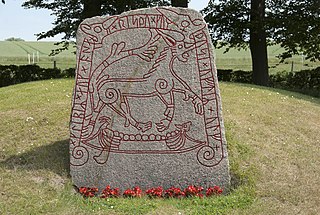
Fenrir or Fenrisúlfr, also referred to as Hróðvitnir and Vánagandr, or Vanargand, is a wolf in Norse mythology. Fenrir, together with Hel and the World Serpent, is a child of Loki and giantess Angrboða. He is attested in the Poetic Edda, compiled in the 13th century from earlier traditional sources, and the Prose Edda and Heimskringla, written in the 13th century by Snorri Sturluson. In both the Poetic Edda and Prose Edda, Fenrir is the father of the wolves Sköll and Hati Hróðvitnisson, is a son of Loki and is foretold to kill the god Odin during the events of Ragnarök, but will in turn be killed by Odin's son Víðarr.

In Norse mythology, Geri and Freki are two wolves which are said to accompany the god Odin. They are attested in the Poetic Edda, a collection of epic poetry compiled in the 13th century from earlier traditional sources, in the Prose Edda, written in the 13th century by Snorri Sturluson, and in the poetry of skalds. The pair has been compared to similar figures found in Greek, Roman and Vedic mythology, and may also be connected to beliefs surrounding the Germanic "wolf-warrior bands", the Úlfhéðnar.

In Norse mythology, Huginn and Muninn are a pair of ravens that fly all over the world, Midgard, and bring information to the god Odin. Huginn and Muninn are attested in the Poetic Edda, compiled in the 13th century from earlier traditional sources: the Prose Edda and Heimskringla; in the Third Grammatical Treatise, compiled in the 13th century by Óláfr Þórðarson; and in the poetry of skalds. The names of the ravens are sometimes modernly anglicized as Hugin and Munin.

In Norse mythology, Ragnarök is a series of events, including a great battle, foretelling the death of numerous great figures, natural disasters, and the submersion of the world in water. After these events, the world will rise again, cleansed and fertile, the surviving and returning gods will meet and the world will be repopulated by two human survivors. Ragnarök is an important event in Norse mythology and has been the subject of scholarly discourse and theory in the history of Germanic studies.
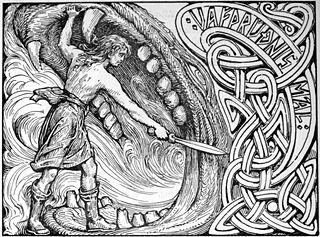
In Norse mythology, Víðarr is a god among the Æsir associated with vengeance. Víðarr is described as the son of Odin and the jötunn Gríðr and is foretold to avenge his father's death by killing the wolf Fenrir at Ragnarök, a conflict he is described as surviving. Víðarr is attested in the Poetic Edda, compiled in the 13th century from earlier traditional sources, the Prose Edda, written in the 13th century by Snorri Sturluson, and is interpreted as depicted with Fenrir on the Gosforth Cross. A number of theories surround the figure, including theories around potential ritual silence and a Proto-Indo-European basis.
In the philologist and fantasy author J. R. R. Tolkien's Middle-earth fiction, a warg is a particularly large and evil kind of wolf that could be ridden by orcs. He derived the name and characteristics of his wargs by combining meanings and myths from Old Norse and Old English. In Norse mythology, a vargr is a wolf, especially the wolf Fenrir that destroyed the god Odin in the battle of Ragnarök, and the wolves Sköll and Hati who perpetually chase the Sun and Moon. In Old English, a wearh is an outcast who may be strangled to death.

The Poetic Edda is the modern name for an untitled collection of Old Norse anonymous narrative poems, which is distinct from the Prose Edda written by Snorri Sturluson. Several versions exist, all primarily of text from the Icelandic medieval manuscript known as the Codex Regius, which contains 31 poems. The Codex Regius is arguably the most important extant source on Norse mythology and Germanic heroic legends. Since the early 19th century, it has had a powerful influence on Scandinavian literature, not only through its stories, but also through the visionary force and the dramatic quality of many of the poems. It has also been an inspiration for later innovations in poetic meter, particularly in Nordic languages, with its use of terse, stress-based metrical schemes that lack final rhymes, instead focusing on alliterative devices and strongly concentrated imagery. Poets who have acknowledged their debt to the Codex Regius include Vilhelm Ekelund, August Strindberg, J. R. R. Tolkien, Ezra Pound, Jorge Luis Borges, and Karin Boye.
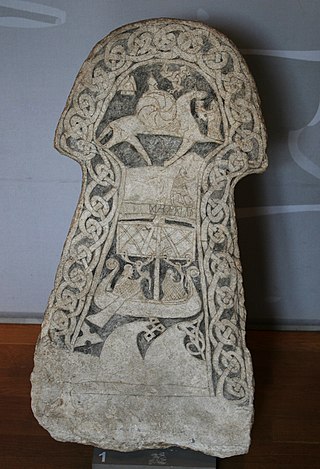
In Norse mythology, a valkyrie is one of a host of female figures who guide souls of the dead to the god Odin's hall Valhalla. There, the deceased warriors become einherjar. When the einherjar are not preparing for the events of Ragnarök, the valkyries bear them mead. Valkyries also appear as lovers of heroes and other mortals, where they are sometimes described as the daughters of royalty, sometimes accompanied by ravens and sometimes connected to swans or horses.
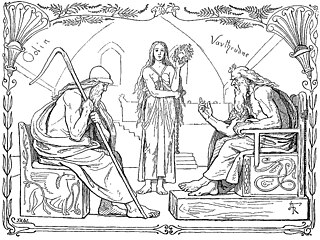
Vafþrúðnir is a wise jötunn in Norse mythology. His name comes from Vaf, which means weave or entangle, and thrudnir, which means strong or mighty. Some interpret it to mean "mighty in riddles". It may be anglicized Vafthruthnir or Vafthrudnir. In the Poetic Edda poem Vafþrúðnismál, Vafþrúðnir acts as Odin's host and opponent in a deadly battle of wits that results in Vafþrúðnir's defeat.
In Norse mythology, Sæhrímnir is the creature killed and eaten every night by the Æsir and einherjar. The cook of the gods, Andhrímnir, is responsible for the slaughter of Sæhrímnir and its preparation in the cauldron Eldhrímnir. After Sæhrímnir is eaten, the beast is brought back to life again to provide sustenance for the following day. Sæhrímnir is attested in the Poetic Edda, compiled in the 13th century from earlier traditional material, and the Prose Edda, written in the 13th century by Snorri Sturluson.

In Norse mythology, Garmr or Garm is a wolf or dog associated with both Hel and Ragnarök, and described as a blood-stained guardian of Hel's gate.

The Battle of Brunanburh was fought in 937 between Æthelstan, King of England, and an alliance of Olaf Guthfrithson, King of Dublin, Constantine II, King of Scotland, and Owain, King of Strathclyde. The battle is often cited as the point of origin for English nationalism: historians such as Michael Livingston argue that "the men who fought and died on that field forged a political map of the future that remains [in modernity], arguably making the Battle of Brunanburh one of the most significant battles in the long history not just of England, but of the whole of the British Isles."
In Norse mythology, Skögul and Geirskögul are valkyries who alternately appear as separate or individual figures. Both valkyries appear in Heimskringla where they seem to be the same being, and are otherwise listed separately in the valkyrie lists in the Poetic Edda poems Völuspá and Grímnismál, the longer of the two valkyrie lists in Skáldskaparmál yet Skögul appears alone in the shorter of the two. Skögul appears in kennings but Geirskögul does not.

Old Norse religion, also known as Norse paganism, is the most common name for a branch of Germanic religion which developed during the Proto-Norse period, when the North Germanic peoples separated into a distinct branch of the Germanic peoples. It was replaced by Christianity and forgotten during the Christianisation of Scandinavia. Scholars reconstruct aspects of North Germanic Religion by historical linguistics, archaeology, toponymy, and records left by North Germanic peoples, such as runic inscriptions in the Younger Futhark, a distinctly North Germanic extension of the runic alphabet. Numerous Old Norse works dated to the 13th-century record Norse mythology, a component of North Germanic religion.

Tanngrisnir and Tanngnjóstr are the goats who pull the chariot of the god Thor in Norse mythology. They are attested in the Poetic Edda, compiled in the 13th century from earlier traditional sources, and the Prose Edda, written by Snorri Sturluson in the 13th century.

Eggþér is a jötunn in Norse mythology. He is the herder of the female jötunn who lives in Járnviðr (Ironwood) and raises monstrous wolves. In the poem Völuspá, Eggþér is described as sitting on a mound and joyfully striking his harp while the red rooster Fjalarr begins to crow to herald the onset of Ragnarök.

The raven banner was a flag, possibly totemic in nature, flown by various Viking chieftains and other Scandinavian rulers during the 9th, 10th and 11th centuries. The flag, as depicted in Norse artwork, was roughly triangular, with a rounded outside edge on which there hung a series of tabs or tassels. It bore a resemblance to ornately carved "weather-vanes" used aboard Viking longships.

Odin is a widely revered god in Germanic paganism. Norse mythology, the source of most surviving information about him, associates him with wisdom, healing, death, royalty, the gallows, knowledge, war, battle, victory, sorcery, poetry, frenzy, and the runic alphabet, and depicts him as the husband of the goddess Frigg. In wider Germanic mythology and paganism, the god was also known in Old English as Wōden, in Old Saxon as Uuôden, in Old Dutch as Wuodan, in Old Frisian as Wêda, and in Old High German as Wuotan, all ultimately stemming from the Proto-Germanic theonym *Wōðanaz, meaning 'lord of frenzy', or 'leader of the possessed'.
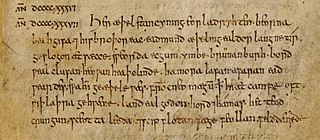
The "Battle of Brunanburh" is an Old English poem. It is preserved in the Anglo-Saxon Chronicle, a historical record of events in Anglo-Saxon England which was kept from the late ninth to the mid-twelfth century. The poem records the Battle of Brunanburh, a battle fought in 937 between an English army and a combined army of Scots, Vikings, and Britons. The battle resulted in an English victory, celebrated by the poem in style and language like that of traditional Old English battle poetry. The poem is notable because of those traditional elements and has been praised for its authentic tone, but it is also remarkable for its fiercely nationalistic tone, which documents the development of a unified England ruled by the House of Wessex.
Battle Beast may refer to:
References
Notes
Bibliography
- Herring, Scott (2008). "A Hawk from a Handsaw: A Note on the Beasts of 'The Battle of Brunanburh'". American Notes and Queries . 21 (1): 9–11. doi:10.3200/anqq.21.1.9-11. S2CID 162360209.
- Honegger, Thomas (1998). "Form and function: The beasts of battle revisited". English Studies . 79 (4): 289–98. doi:10.1080/00138389808599134.
- Magoun, Francis Peabody (1955). "The Theme of the Beasts of Battle in Anglo- Saxon Poetry". Neuphilologische Mitteilungen . 56: 81–90.
- Niles, John D. (2007). "Pagan survivals and popular belief". In Malcolm Godden (ed.). The Cambridge Companion to Old English Literature. Michael Lapidge. Cambridge UP. pp. 126–41. ISBN 978-0-521-37794-2.